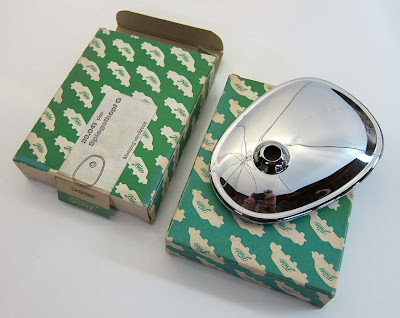In my last Csepel update I had received and installed a new gear shift shaft and gear shift lever to replace the ones on my bike which had stripped splines. I also replaced the kick start lever which had some not so good repairs done to it previous to me purchasing the bike. Once everything was back together, I rode it around a little bit. I don't have tags for it yet so I was sticking close to home. After the first ride everything seemed great!

Later in the day my wife wanted to see the bike run, so I fired it up for another ride. Unfortunately the second ride of the day wasn't as fun as the first. The clutch began malfunction. I brought the bike in and opened up the clutch case and found a bakelite disc in the clutch stack that had broken and was in pieces in the bottom of the case. After consulting with a supplier of parts for eastern European bikes, I learned this bakelite plate was not a Csepel part and did not belong in the clutch stack. The original clutch friction plates were wore quite thin and I'm guessing somebody used the bakelite disc as a shim or spacer.
These are the old clutch plates removed and the broken bakelite shim that was in the stack.
The bummer about owning an obscure Hungarian bike in the US is when the bike is down in need of a part, it generally takes between 1-2 months to find the part and have it shipped to the US. The good thing is, I really haven't had that much trouble finding the parts. I recently received some new friction plates and am ready to put the bike back together. Originally there were five of the friction plates, but the new ones are much thicker and I'll only be using four.
You can see the 4 new plates are thicker than the old 5 plates.
Soaking the new friction plates in gear oil prior to installation.
These are the original clutch springs. Some of them have been overstretched or bent and are longer than other ones. The first time I put the clutch back together with these, some were loose and I had two break, so I decided I needed to replace all the springs. Also before I reassembled the clutch, I borrowed a boroscope from a friend to make sure there weren't any pieces of bakelite from the broken plate that had made their way into the gearbox. Everything looked clean inside the gearbox.
I didn't want to wait a month or more for clutch springs and figured I could find something in the US that would work. It took some trial and error but I finally found some Polini clutch springs for a Honda Hobbit scooter that seemed like a good match.
Since I am only using 4 friction plates, I had a steel plate left over which I doubled up in the center of the stack to give me a little extra thickness. The clutch action felt really good with this combination of plates and the new springs.
Everything is back together. All that's left is to strain the gear oil and put it back in the bike.
S**T!!!!! I was straining the gear oil and at the bottom of the strainer there was a loose 5mm ball bearing. I believe this is the ball bearing that goes between the clutch throwout rod and spindle. It probably came out on one of the many times I had the clutch apart. It would also explain why my throwout pin was barely long enough to get a nut on. Looks like I'm going to have to disassemble the clutch one more time.









































